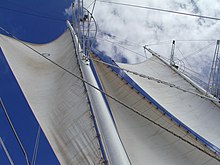More beautiful

Schooner , rarely and out of date also schooner or schuner , describes a sailing ship with a certain rigging . A schooner is a sailing ship that has two or more masts, has sloping sails on all masts as the main sail and the foremost mast is lower than (one) the rear (s). Originally schooners only had two masts, later schooners with three or more masts were also built (e.g. three-masted schooner Amphitrite ); especially in the United States , schooners with five or more masts were built in the late 19th and early 20th centuries.
The front mast ( foremast ) a schooner will schooner mast called. If a saver on the foremast a gaff sail , they say saver sailing . As a staysail schooner mast in front of the usually two to jib sail and a jib down.
Stay sail schooners have triangular stay sails instead of gaff sails and a Bermuda sail on the aft mast . In addition, a sail called a “ fisherman ” can be set between the mast tops . The usual foresails (outer jib, jib, forestay sails) are often used on the foremast. This rigging allows the ships to sail very close to the wind .
Most staysail schooners are three-masted, but there are also ships with a different number of masts.
Two masters, the rear mast of which is the smaller, are called in contrast to the schooner ketch or yawl .
history
The first guaranteed launch of a schooner took place in Gloucester (about 50 km northeast of Boston ) in 1713 . A spectator is said to have noted when launching: “There she scoons” or “Oh, see how she scoons” (“There she slides there” or “Oh see how she glides”). The builder of this ship, a Captain Andrew Robinson, then coined the word "Schooner". Its name comes from a verb from the Scottish Clydesdale dialect: "to scoon" (for example, "let stones slide over the water", also "slide"). The origin of this type of rigging came from the Netherlands .
Initially, schooners only had two masts and were mainly rigged with a rake ( topsail schooner , schoonerbrigg ). They were fast ships and were used in courier services, but also for pirate hunting . In North America, the wind conditions favor the use of gaff sails even for larger ships in coastal shipping, as there are winds from or to the coast that make it very difficult for the yard ships to approach ports in headwinds. The pure gaff schooner developed with mostly two or three masts, since 1864 with four, since 1888 with five, since 1900 with six masts. These schooners then no longer had yards , but the sails consisted exclusively of gaff sails and staysails . Only a small crew was required to operate these sails from the deck , especially since steam-powered auxiliary units were used. An important wooden shipyard where many schooners and brigantines were built was that of Matthew Turner in Benicia , who also developed the rigging .
The large four-, five- and six-masted schooners were used (from 1900) as cargo ships for coal, wood, oil, etc. The largest schooner ever built (made of steel) was the Thomas W. Lawson from 1902 with seven masts, 25 sails and a crew of approx. 18 (compared to approx. 45 men for a five-masted full ship like the Prussia ). As the largest wooden schooner, the 3,730 gross tons (GRT) large Wyoming was launched in 1909 in Bath , Maine, USA . It was the longest wooden ship in the world ever built and was used to transport coal . The rigging of the five five-masted schooner of Bremen shipping Remarkably FA Vinnen & Co. with Marsrahtopp (three sailing at four yards) (so-called. Foremast and the center pole Rahschoner ).
Smaller schooners were used as fishing and pilot schooners ( Newfoundland schooners ). The races between the US and Canadian fishermen, which have been held in a regulated form since 1920, became famous. The Canadian Bluenose of 1921 achieved legendary fame .
The Spanish training ship Juan Sebastián de Elcano , a four-masted topsail schooner (with Mars wire top), is currently the largest schooner at sea.
variants

Depending on the type of sail arrangement, different types of schooners are distinguished. The construction of the hull does not matter because the schooner is a type of rigging.
Schooner (in the strict sense)
Two or three mast construction with a protective sail on the first mast, main sail on the second mast and, if available, mizzen sail on the third mast.

Staysail schooner
Staysail schooners are three-masted and two-masted, the sail arrangement follows the schooner principle. The trapezoidal sails are arranged against each other between the masts. The sails complement each other and allow faster travel before the wind. A mizzen sail is used on the third mast .
Topsail schooner
Lead a square sail (English: top sail) at least on the front mast above the schooner sail.
See also
Web links
- Sailing Ships - Schooners (English)
- The terminology of the Schonerriggs (by Jürgen Rabbel) (PDF; 258 kB) , published by the Ship History Archive in Flensburg
literature
- Herbert Karting: German schooners (in four volumes). Hauschild, Bremen, ISBN 978-3-89757-104-4 , ... 127-3, ... 178-5, ... 193-8
- Otmar Schäuffelen: The last great sailing ships. 5th completely revised and improved edition. Delius Kläring Verlag, Bielefeld 1986, ISBN 3-7688-0483-6 .
- David R. MacGregor: The Schooner: Its Design and Development from 1600 to the Present . US Naval Inst Pr, 2001, ISBN 978-1557509871 .
- Karl Heinz Marquardt: The Global Schooner: Origins, Development, Design and Construction, 1695-1845 . US Naval Inst Pr, 2003, ISBN 978-1591143284 .
Individual evidence
- ↑ This was a tag. The first new four-mast schooner was built in 1880; see http://www.esys.org/bigship/Gaffelschoner.html
- ↑ The first six-masted schooner was the George W. Wells , built in Cambden 1900, stranded at Cape Hatteras in 1915, see http://www.afn.org/~stan/ships.html

